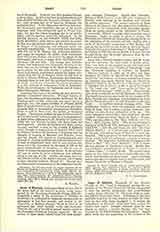

Isaac of Nineveh, Nestorian bishop of that city in the latter half of the seventh century, being consecrated by the Nestorian Patriarch George (660-80). Originally a monk of the monastery of Bethabe in Kurdistan, he abdicated for unknown reasons after an episcopate of but five months, and retired to the monastery of Rabban Shapur, where he died at an advanced age, blind through study and austerity. Towards the end of his life he passed under a cloud as his Nestorian orthodoxy became suspected. He was author of three theses, which found but little acceptance amongst Nestorians. Daniel Bar Tubanita, Bishop of Beth Garmai (some 100 miles southeast of Mossul), took umbrage at his teaching and became his ardent opponent. The precise contents of these theses are not known, but they were of too Catholic a character to be compatible with Nestorian heresy. From an extant prayer of his, addressed to Christ, it is certainly difficult to realize that its author was a Nestorian. Eager to claim so great a writer, the Monophysites falsified his biography, placing his life at the beginning of the seventh century, making him a monk of the Jacobite monastery of Mar Mattai, and stating that he retired to the desert of Scete in Egypt. Since the discovery of Ishodenah’s “Book of Chastity” by Chabot in 1895 the above details of Isaac’s life are beyond doubt, and all earlier accounts must be corrected accordingly.
Isaac was a fruitful ascetical writer and his works were for centuries the main food of Syrian piety. Only very little of the original Syriac has been published—two chapters on “Grades of Knowledge” and the “Essential Qualities of Virtues” by Zingerle (“Monum. Syriaca”, I, 1869, pp. 97-101), and three dialogues by Chabot at the end of his treatise “De Isaac’ vita” (see below). A German translation of some six chapters was made directly from the Syriac by Bickell (“Biblioth. der Kirchenvat.”, Kempten, 1874). A complete list of Isaac’s works is given by Chabot in “De Isaaci vita” and “Notes sur la litt. Syr.” in the “Revue Semitique” (1896), p. 254. Isaac’s works were early translated in Arabic, Ethiopic, and Greek. The Greek translation was made by two monks of St. Saba, Patrick and Abraham, and published by Nicephorus Theodoces under the title Tou osiou patros emon Isaak… ta eurethenta asketika (Leipzig, 1870). This publication, however, does not represent any precise work of Isaac, but is rather a corpus asceticum, containing treatises, letters, colloquies, all in one. Two Latin recensions thereof have been published: the one entitled “Sermones beati Isaaci de Syria” (Venice, 1506) and the other in the “Max. biblioth. vet. Pat-rum.”, XIII (Lyons, 1677). This latter recension is reprinted in Gallandi, XII, and again in Migne, P.G., LXXXVI, 1, 811-86, and bears the title “De Contemptu Mundi”. It is erroneously ascribed to Isaac of Antioch, with whom Isaac of Nineveh is often confounded. The Latin gives but half the contents of the Greek, which itself has undergone a number of manipulations. The long letter to Simeon of Caesarea published in Mai’s “November Patr. Biblioth.”, VIII, 3, forms the last chapter of Theodorus’s Greek. Marius Besson published apophthegmata of Isaac’s in Greek in “Oriens Christ.”, I (1901), 46-60. The Arabic translation of this corpus asceticum is much fuller than the Greek, and divided into four books. Isaac’s writings possess passages of singular beauty and elevation, and remind the reader of Thomas a Kempis.
J. P. ARENDZEN

